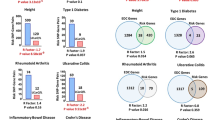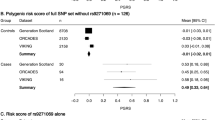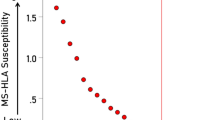Abstract
Discrepant findings have been reported regarding an association of the apolipoprotein E (APOE) gene with the clinical course of multiple sclerosis (MS). To resolve these discrepancies, we examined common sequence variation in six candidate genes residing in a 380-kb genomic region surrounding and including the APOE locus for an association with MS severity. We genotyped at least three polymorphisms in each of six candidate genes in 1540 Caucasian MS families (729 single-case and multiple-case families from the United States, 811 single-case families from the UK). By applying the quantitative transmission/disequilibrium test to a recently proposed MS severity score, the only statistically significant (P=0.003) association with MS severity was found for an intronic variant in the Herpes Virus Entry Mediator-B Gene (PVRL2). Additional genotyping extended the association to a 16.6 kb block spanning intron 1 to intron 2 of the gene. Sequencing of PVRL2 failed to identify variants with an obvious functional role. In conclusion, the analysis of a very large data set suggests that genetic polymorphisms in PVRL2 may influence MS severity and supports the possibility that viral factors may contribute to the clinical course of MS, consistent with previous reports.
This is a preview of subscription content, access via your institution
Access options
Subscribe to this journal
Receive 6 digital issues and online access to articles
$119.00 per year
only $19.83 per issue
Buy this article
- Purchase on Springer Link
- Instant access to full article PDF
Prices may be subject to local taxes which are calculated during checkout



Similar content being viewed by others
References
Hauser SL, Goodkin SL . Multiple sclerosis and other demyelinating diseases. In: Braunwald E, Fauci AD, Kasper DL, Hauser SL, Longo DL, Jameson JL (eds). Harrison's Principle of Internal Medicine. McGraw Hill: New York, 2001, pp 2452–2461.
Weinshenker BG . Natural history of multiple sclerosis. Ann Neurol 1994; 36 (Suppl): S6–S11.
Kantarci OH, Weinshenker BG . Natural history of multiple sclerosis. Neurol Clin 2005; 23: 17–38.
Ebers GC, Sadovnick AD, Risch NJ . A genetic basis for familial aggregation in multiple sclerosis. Canadian Collaborative Study Group. Nature 1995; 377: 150–151.
Sadovnick AD, Armstrong H, Rice G, Bulman DE, Hashimoto L, Paty DW et al. A population based study of multiple sclerosis in twins: update. Ann Neurol 1993; 33: 281–285.
Kantarci OH, De Andrade M, Weinshenker BG . Identifying disease modifying genes in multiple sclerosis. J Neuroimmunol 2002; 123: 144–159.
Chapman J, Sylantiev C, Nisipeanu P, Korczyn AD . Preliminary observations on APOE epsilon4 allele and progression of disability in multiple sclerosis. Arch Neurol 1999; 56: 1484–1487.
Evangelou N, Jackson M, Beeson D, Palace J . Association of the APOE epsilon4 allele with disease activity in multiple sclerosis. J Neurol Neurosurg Psychiatry 1999; 67: 203–205.
Hogh P, Oturai A, Schreiber K, Blinkenberg M, Jorgensen OS, Ryder L et al. Apoliprotein E and multiple sclerosis: impact of the epsilon-4 allele on susceptibility, clinical type and progression rate. Mult Scler 2000; 6: 226–230.
Fazekas F, Strasser-Fuchs S, Kollegger H, Berger T, Kristoferitsch W, Schmidt H et al. Apolipoprotein E epsilon4 is associated with rapid progression of multiple sclerosis. Neurology 2001; 57: 853–857.
Fazekas F, Strasser-Fuchs S, Schmidt H, Enzinger C, Ropele S, Lechner A et al. Apolipoprotein E genotype related differences in brain lesions of multiple sclerosis. J Neurol Neurosurg Psychiatry 2000; 69: 25–28.
Chapman J, Vinokurov S, Achiron A, Karussis DM, Mitosek-Szewczyk K, Birnbaum M et al. APOE genotype is a major predictor of long-term progression of disability in MS. Neurology 2001; 56: 312–316.
Schmidt S, Barcellos LF, DeSombre K, Rimmler JB, Lincoln RR, Bucher P et al. Association of polymorphisms in the apolipoprotein E region with susceptibility to and progression of multiple sclerosis. Am J Hum Genet 2002; 70 (3): 708–717.
Kantarci OH, Hebrink DD, Achenbach SJ, Pittock SJ, Altintas A, Schaefer-Klein JL et al. Association of APOE polymorphisms with disease severity in MS is limited to women. Neurology 2004; 62: 811–814.
Enzinger C, Ropele S, Smith S, Strasser-Fuchs S, Poltrum B, Schmidt H et al. Accelerated evolution of brain atrophy and ‘black holes’ in MS patients with APOE-epsilon 4. Ann Neurol 2004; 55: 563–569.
Ferri C, Sciacca FL, Veglia F, Martinelli F, Comi G, Canal N et al. APOE e2-4 and -491 polymorphisms are not associated with MS. Neurology 1999; 53: 888–889.
Weatherby SJ, Mann CL, Fryer AA, Strange RC, Hawkins CP, Stevenson VL et al. No association between the APOE epsilon4 allele and outcome and susceptibility in primary progressive multiple sclerosis. J Neurol Neurosurg Psychiatry 2000; 68: 532.
Pirttila T, Haanpaa M, Mehta PD, Lehtimaki T . Apolipoprotein E (APOE) phenotype and APOE concentrations in multiple sclerosis and acute herpes zoster. Acta Neurol Scand 2000; 102: 94–98.
Masterman T, Zhang Z, Hellgren D, Salter H, Anvret M, Lilius L et al. APOE genotypes and disease severity in multiple sclerosis. Mult Scler 2002; 8: 98–103.
Savettieri G, Andreoli V, Bonavita S, Cittadella R, Caltagirone C, Fazio MC et al. Apolipoprotein E genotype does not influence the progression of multiple sclerosis. J Neurol 2003; 250: 1094–1098.
Niino M, Kikuchi S, Fukazawa T, Yabe I, Tashiro K . Polymorphisms of apolipoprotein E and Japanese patients with multiple sclerosis. Mult Scler 2003; 9: 382–386.
Guerrero AL, Bueno V, Hernandez MT, Martin-Serradilla JI, Carrasco E, Cuadrado I . Apolipoprotein E polymorphism as a predictor of progression of multiple sclerosis. Neurologia 2003; 18: 146–148.
Santos M, do Carmo CM, Edite RM, Jose SM, Monteiro M, Valenca A et al. Genotypes at the APOE and SCA2 loci do not predict the course of multiple sclerosis in patients of Portuguese origin. Mult Scler 2004; 10: 153–157.
Barcellos LF, Thomson G, Carrington M, Schafer J, Begovich AB, Lin P et al. Chromosome 19 single-locus and multilocus haplotype associations with multiple sclerosis. Evidence of a new susceptibility locus in Caucasian and Chinese patients. JAMA 1997; 278: 1256–1261.
Pericak-Vance MA, Rimmler JB, Martin ER, Haines JL, Garcia ME, Oksenberg JR et al. Linkage and association analysis of chromosome 19q13 in multiple sclerosis. Neurogenetics 2001; 3: 195–201.
Corder EH, Saunders AM, Strittmatter WJ, Schmechel DE, Gaskell PC, Small GW et al. Gene dose of apolipoprotein E type 4 allele and the risk of Alzheimer's disease in late onset families. Science 1993; 261: 921–923.
Li Y-J, Hauser MA, Scott WK, Martin ER, Booze MW, Qin XJ et al. Apolipoprotein E controls the risk and age at onset of Parkinson Disease. Neurology 2004; 62: 2005–2009.
Li Y-J, Pericak-Vance MA, Haines JL, Siddique N, McKenna-Yasek D, Hung WY et al. Apolipoprotein E is associated with age at onset of amyotrophic lateral sclerosis. Neurogenetics 2004; 5: 209–213.
Ignatius MJ, Gebicke-Harter PJ, Skene JH, Schilling JW, Weisgraber KH, Mahley RW et al. Expression of apolipoprotein E during nerve degeneration and regeneration. Proc Natl Acad Sci USA 1986; 83: 1125–1129.
Laskowitz DT, Horsburgh K, Roses AD . Apolipoprotein E and the CNS response to injury. J Cereb Blood Flow Metab 1998; 18: 465–471.
Karussis D, Michaelson DM, Grigoriadis N, Korezyn AD, Mizrachi-Koll R, Chapman S et al. Lack of apolipoprotein-E exacerbates experimental allergic encephalomyelitis. Mult Scler 2003; 9: 476–480.
Helgason A, Yngvadottir B, Hrafnkelsson B, Gulcher J, Stefansson K . An Icelandic example of the impact of population structure on association studies. Nat Genet 2005; 37: 90–95.
Martin ER, Lai EH, Gilbert JR, Rogala AR, Afshari AJ, Riley J et al. SNPing away at complex diseases: analysis of single-nucleotide polymorphisms around APOE in Alzheimer disease. Am J Hum Genet 2000; 67: 383–394.
Rosche B, Cepok S, Stei S, Vogel F, Grummel V, Hoffmann S et al. The role of the polio virus receptor and the herpesvirus entry mediator B genes for the development of MS. J Neuroimmunol 2004; 156: 171–177.
Burwick RM, Ramsay PP, Haines JL, Hauser SL, Oksenberg JR, Pericak-Vance MA et al. APOE in multiple sclerosis susceptibility and disease severity: meta- and pooled analyses. Neurol 2006; 66: 1373–1383.
Martinez WM, Spear PG . Structural features of nectin-2 (HveB) required for herpes simplex virus entry. J Virol 2001; 75: 11185–11195.
Nissim-Rafinia M, Kerem B . The splicing machinery is a genetic modifier of disease severity. Trends Genet 2005; 21: 480–483.
Hiller M, Huse K, Szafranski K, Jahn N, Hampe J, Schreiber S et al. Single-nucleotide polymorphisms in NAGNAG acceptors are highly predictive for variations of alternative splicing. Am J Hum Genet 2006; 78: 291–302.
Ueda H, Howson JM, Esposito L, Heward J, Snook H, Chamberlain G et al. Association of the T-cell regulatory gene CTLA4 with susceptibility to autoimmune disease. Nature 2003; 423: 506–511.
Kramer MF, Cook WJ, Roth FP, Zhu J, Holman H, Knipe DM et al. Latent herpes simplex virus infection of sensory neurons alters neuronal gene expression. J Virol 2003; 77: 9533–9541.
Khanna KM, Lepisto AJ, Decman V, Hendricks RL . Immune control of herpes simplex virus during latency. Curr Opin Immunol 2004; 16: 463–469.
Decman V, Kinchington PR, Harvey SA, Hendricks RL . Gamma interferon can block herpes simplex virus type 1 reactivation from latency, even in the presence of late gene expression. J Virol 2005; 79: 10339–10347.
Ferrante P, Mancuso R, Pagani E, Guerini FR, Calvo MG, Saresella M et al. Molecular evidences for a role of HSV-1 in multiple sclerosis clinical acute attack. J Neurovirol 2000; 6 (Suppl 2): S109–S114.
Fazakerley JK, Walker R . Virus demyelination. J Neurovirol 2003; 9: 148–164.
Bello-Morales R, Fedetz M, Alcina A, Tabares E, Lopez-Guerrero JA . High susceptibility of a human oligodendroglial cell line to herpes simplex type 1 infection. J Neurovirol 2005; 11: 190–198.
Kastrukoff LF, Kim SU . Oligodendrocytes from human donors differ in resistance to herpes simplex virus 1 (HSV-1). Glia 2002; 38: 87–92.
Challoner PB, Smith KT, Parker JD, MacLeod DL, Coulter SN, Rose TM et al. Plaque-associated expression of human herpesvirus 6 in multiple sclerosis. Proc Natl Acad Sci USA 1995; 92: 7440–7444.
Goodkin DE, Doolittle TH, Hauser SL, Ransohoff RM, Roses AD, Rudick RA . Diagnostic criteria for multiple sclerosis research involving multiply affected families. Arch Neurol 1991; 48: 805–807.
Haines JL, Ter-Minassian M, Bazyk A, Gusella JF, Kim DJ, Terwedow H et al. A complete genomic screen for multiple sclerosis underscores a role for the major histocompatability complex. Nat Genet 1996; 13: 469–471.
Barcellos LF, Begovich AB, Reynolds RL, Caillier SJ, Brassat D, Schmidt S et al. Linkage and association with the NOS2A locus on chromosome 17q11 in multiple sclerosis. Ann Neurol 2004; 55: 793–800.
Hensiek AE, Roxburgh R, Smilie B, Coraddu F, Akesson E, Holmans P et al. Updated results of the United Kingdom linkage-based genome screen in multiple sclerosis. J Neuroimmunol 2003; 143: 25–30.
Roxburgh RH, Seaman SR, Masterman T, Hensiek AE, Sawcer SJ, Vukusic S et al. Multiple sclerosis severity score: using disability and disease duration to rate disease severity. Neurology 2005; 64: 1144–1151.
Kurtzke JF . Rating neurologic impairment in multiple sclerosis: an expanded disability status scale (EDSS). Neurology 1983; 33: 1444–1452.
Vance JM, Ben Othmane K . Methods of genotyping. In: Haines JL, Pericak-Vance MA (eds). Approaches to Gene Mapping in Complex Human Diseases. Wiley-Liss: New York, 1998, pp 213–228.
Xu H, Gregory SG, Hauser ER, Stenger JE, Pericak-Vance MA, Vance JM et al. SNPselector: a web tool for selecting SNPs for genetic association studies. Bioinformatics 2005; 21: 4181–4186.
Kalman B, Li S, Chatterjee D, O'Connor J, Voehl MR, Brown MD et al. Large scale screening of the mitochondrial DNA reveals no pathogenic mutations but a haplotype associated with multiple sclerosis in Caucasians. Acta Neurol Scand 1999; 99: 16–25.
Andrews HE, Nichols PP, Bates D, Turnbull DM . Mitochondrial dysfunction plays a key role in progressive axonal loss in Multiple Sclerosis. Med Hypotheses 2005; 64: 669–677.
Bonetti B, Stegagno C, Cannella B, Rizzuto N, Moretto G, Raine CS . Activation of NF-kappaB and c-jun transcription factors in multiple sclerosis lesions. Implications for oligodendrocyte pathology. Am J Pathol 1999; 155: 1433–1438.
Miterski B, Bohringer S, Klein W, Sindern E, Haupts M, Schimrigk S et al. Inhibitors in the NFkappaB cascade comprise prime candidate genes predisposing to multiple sclerosis, especially in selected combinations. Genes Immun 2002; 3: 211–219.
Flores N, Duran C, Blasco MR, Puerta C, Dorado B, Garcia-Merino A et al. NFkappaB and AP-1 DNA binding activity in patients with multiple sclerosis. J Neuroimmunol 2003; 135: 141–147.
Kurtzke JF . Epidemiologic evidence for multiple sclerosis as an infection. Clin Microbiol Rev 1993; 6: 382–427.
Dalgleish AG . Viruses and multiple sclerosis. Acta Neurol Scand Suppl 1997; 169: 8–15.
Monteyne P, Bureau JF, Brahic M . Viruses and multiple sclerosis. Curr Opin Neurol 1998; 11: 287–291.
Haynes C, Speer MC, Peedin M, Roses AD, Haines JL, Vance JM et al. PEDIGENE: A comprehensive data management system to facilitate efficient and rapid disease gene mapping. Am J Hum Genet 1995; 57: A193.
O'Connell JR, Weeks DE . PedCheck: a program for identification of genotype incompatibilities in linkage analysis. Am J Hum Genet 1998; 63: 259–266.
Abecasis GR, Cherny SS, Cookson WO, Cardon LR . Merlin – rapid analysis of dense genetic maps using sparse gene flow trees. Nat Genet 2002; 30: 97–101.
Zaykin D, Zhivotovsky L, Weir BS . Exact tests for association between alleles at arbitrary numbers of loci. Genetica 1995; 96: 169–178.
Hartl DL . A Primer of Population Genetics, 2nd edn. Sinauer Associates Inc.: Sunderland, MA, 1987.
Barrett JC, Fry B, Maller J, Daly MJ . Haploview: analysis and visualization of LD and haplotype maps. Bioinformatics 2005; 21: 263–265.
Monks SA, Kaplan NL . Removing the sampling restrictions from family-based tests of association for a quantitative-trait locus. Am J Hum Genet 2000; 66: 576–592.
Abecasis GR, Cardon LR, Cookson WO . A general test of association for quantitative traits in nuclear families. Am J Hum Genet 2000; 66: 279–292.
Nyholt DR . A simple correction for multiple testing for single-nucleotide polymorphisms in linkage disequilibrium with each other. Am J Hum Genet 2004; 74: 765–769.
Li J, Ji L . Adjusting multiple testing in multilocus analyses using the eigenvalues of a correlation matrix. Heredity 2005; 95: 221–227.
Li YJ, Scott WK, Zhang L, Lin PI, Oliveira SA, Skelly T et al. Revealing the role of glutathione S-transferase omega in age-at-onset of Alzheimer and Parkinson diseases. Neurobiol Aging (E-pub ahead of print (doi:10.1016/j.newobiolaging2005:05.013).
Laird NM, Horvath S, Xu X . Implementing a unified approach to family-based tests of association. Genet Epidemiol 2000; 19 (Suppl 1): S36–S42.
Horvath S, Xu X, Lake SL, Silverman EK, Weiss ST, Laird NM . Family-based tests for associating haplotypes with general phenotype data: application to asthma genetics. Genet Epidemiol 2004; 26 (1): 61–69.
Gabriel SB, Schaffner SF, Nguyen H, Moore JM, Roy J, Blumenstiel B et al. The structure of haplotype blocks in the human genome. Science 2002; 296: 2225–2229.
Acknowledgements
We thank all patients and families who generously participated in this study. We thank the collaborating clinics and physicians for referring individuals to the study. This research was supported by National Institutes of Health Grants NS32830, NS26799 and NS049477.
Author information
Authors and Affiliations
Consortia
Corresponding author
Additional information
Supplementary Information accompanies the paper on Genes and Immunity's website (http://www.nature.com/gene)
Supplementary information
Rights and permissions
About this article
Cite this article
Schmidt, S., Pericak-Vance, M., Sawcer, S. et al. Allelic association of sequence variants in the herpes virus entry mediator-B gene (PVRL2) with the severity of multiple sclerosis. Genes Immun 7, 384–392 (2006). https://doi.org/10.1038/sj.gene.6364311
Received:
Revised:
Accepted:
Published:
Issue Date:
DOI: https://doi.org/10.1038/sj.gene.6364311
Keywords
This article is cited by
-
Nectin-2 in general and in the brain
Molecular and Cellular Biochemistry (2022)
-
Members 6B and 14 of the TNF receptor superfamily in multiple sclerosis predisposition
Genes & Immunity (2011)
-
Mining for single nucleotide polymorphisms in pig genome sequence data
BMC Genomics (2009)
-
The genetics of multiple sclerosis: SNPs to pathways to pathogenesis
Nature Reviews Genetics (2008)
-
Interleukin 7 receptor α chain ( IL7R ) shows allelic and functional association with multiple sclerosis
Nature Genetics (2007)



